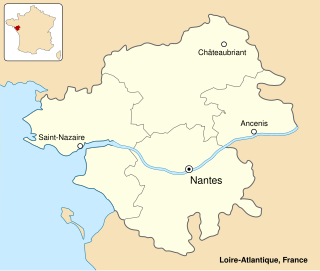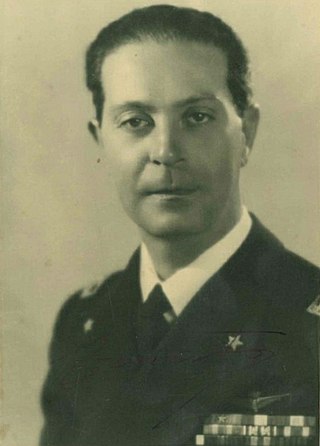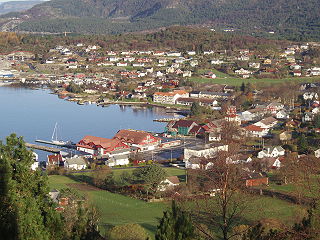
The Royal Norwegian Navy is the branch of the Norwegian Armed Forces responsible for naval operations of Norway, including those of the Norwegian Coast Guard. As of 2008, the Royal Norwegian Navy consists of approximately 3,700 personnel and 70 vessels, including 4 heavy frigates, 6 submarines, 14 patrol boats, 4 minesweepers, 4 minehunters, 1 mine detection vessel, 4 support vessels and 2 training vessels.

The St Nazaire Raid or Operation Chariot was a British amphibious attack on the heavily defended Normandie dry dock at St Nazaire in German-occupied France during the Second World War. The operation was undertaken by the Royal Navy (RN) and British Commandos under the auspices of Combined Operations Headquarters on 28 March 1942. St Nazaire was targeted because the loss of its dry dock would force any large German warship in need of repairs, such as Tirpitz, sister ship of Bismarck, to return to home waters by running the gauntlet of the Home Fleet of the Royal Navy and other British forces, via the English Channel or the North Sea.

Operation Agreement was a ground and amphibious operation carried out by British, Rhodesian and New Zealand forces on Axis-held Tobruk from 13 to 14 September 1942, during the Second World War. A Special Interrogation Group party, fluent in German, took part in missions behind enemy lines. Diversionary actions extended to Benghazi, Jalo oasis and Barce. The Tobruk raid was an Allied disaster; the British lost several hundred men killed and captured, one cruiser, two destroyers, six motor torpedo boats and dozens of small amphibious craft.

The Channel Dash was a German naval operation during the Second World War. A Kriegsmarine squadron comprising the two Scharnhorst-class battleships, the heavy cruiser Prinz Eugen and their escorts was evacuated from Brest in Brittany to German ports. Scharnhorst and Gneisenau had arrived in Brest on 22 March 1941 after the success of Operation Berlin in the Atlantic. More raids were planned and the ships were refitted at Brest. The ships were a threat to Allied trans-Atlantic convoys and RAF Bomber Command attacked them from 30 March 1941. Gneisenau was hit on 6 April 1941 and Scharnhorst on 24 July 1941, after dispersal to La Pallice. In late 1941, Adolf Hitler ordered the Oberkommando der Marine to plan an operation to return the ships to German bases against a British invasion of Norway. The short route up the English Channel was preferred to a detour around the British Isles for surprise and air cover by the Luftwaffe and on 12 January 1942, Hitler gave orders for the operation.

The Decima Flottiglia MAS was an Italian flotilla, with marines and commando frogman unit, of the Regia Marina. The acronym MAS also refers to various light torpedo boats used by the Regia Marina during World War I and World War II.

The motor gunboat (MGB) was a small, high-speed British military vessel of the Second World War, which was armed with a mix of guns, in contrast to the physically similar motor torpedo boat (MTB), whose main offensive weapon were torpedoes. The small size of the MGBs, and their high speed, made them difficult targets for German E-boats, though, like their opponents, they were limited by heavy weather, because they did not provide a stable-enough platform to aim the guns. The large number of guns meant the crew was relatively large, numbering as high as thirty men on the largest boats.

Britain's commando frogman force is now the Special Boat Service (SBS), whose members are drawn largely from the Royal Marines. They perform various operations on land as well as in the water. Until the late 1990s, all members of the Special Air Service (SAS) Boat Troop were trained as commando frogmen.

The Welman submarine was a Second World War one-man British midget submarine developed by the Special Operations Executive. It only saw action once and was not particularly successful.

The Norwegian armed forces in exile were remnants of the armed forces of Norway that continued to fight the Axis powers from Allied countries, such as Britain and Canada, after they had escaped the German conquest of Norway during World War II.

The Fairmile D motor torpedo boat was a type of British motor torpedo boat (MTB) and motor gunboat (MGB), conceived by entrepreneur Noel Macklin of Fairmile Marine and designed by naval architect Bill Holt for the Royal Navy. Nicknamed "Dog Boats", they were designed to be assembled in kit form mass-produced by the Fairmile organisation and assembled at dozens of small boatbuilding yards around Britain, to combat the known advantages of the German E-boats over previous British coastal craft designs. At 115 feet in length, they were bigger than earlier MTB or motor gunboat (MGB) designs but slower, at 30 knots compared to 40 knots.

Coastal Forces was a division of the Royal Navy initially established during World War I, and then again in World War II under the command of Rear-Admiral, Coastal Forces. It remained active until the last minesweepers to wear the "HM Coastal Forces" cap tally were taken out of reserve in 1968. The division received more gallantry awards than any other branch of the Royal Navy during that period.

The Coastal Forces of the Royal Canadian Navy (RCN) was a specialized naval force of well-armed, small and fast motor launch (ML) and motor torpedo boat (MTB) flotillas, primarily crewed by members of the Royal Canadian Naval Volunteer Reserve (RCNVR). Tasked with escort, coastal defence, anti-submarine, minesweeping and search and rescue duties, the Coastal Forces of the RCN contributed to securing Allied sea lines of communication off the coasts of Canada and Britain during the Second World War.
Vorpostenboot, also referred to as VP-Boats, flakships or outpost boats, were German patrol boats which served during both World Wars. They were used around coastal areas and in coastal operations, and were tasked with – among other things – coastal patrol, ship escort, and naval combat.

Coastal Motor Boat was a small high-speed British torpedo boat used by the Royal Navy in the First World War and up to end of the Second World War.

Stord is an island in Vestland county, Norway. Located in the traditional district of Sunnhordland, the island is part of the municipalities of Stord and Fitjar. The largest settlements on the island are the town of Leirvik and the villages of Sagvåg and Fitjar.

The Adriatic campaign of World War II was a minor naval campaign fought during World War II between the Greek, Yugoslavian and Italian navies, the Kriegsmarine, and the Mediterranean squadrons of the United Kingdom, France, and the Yugoslav Partisan naval forces. Considered a somewhat insignificant part of the naval warfare in World War II, it nonetheless saw interesting developments, given the specificity of the Dalmatian coastline.
MTB 345 was an experimental motor torpedo boat constructed in 1941, which saw limited service with the Royal Navy before being transferred to the exiled Royal Norwegian Navy on 16 March 1943. She sailed with the Royal Norwegian Navy for three months in 1943, until captured by German forces on 28 July 1943, during her second mission to the coast of occupied Norway. Two days after their capture, the crew of MTB 345 were executed by the Germans based on Hitler's Commando Order. Following their capture of MTB 345, the Germans pressed the motor torpedo boat into Kriegsmarine service, renaming her SA 12. The fate of SA 12 since December 1943 is unknown.

HMS Ekins (K552) was a British Captain-class frigate of the Royal Navy that served during World War II. Originally constructed as a United States Navy Buckley class destroyer escort, she served in the Royal Navy from 1943 to 1945.

Kondor was the fifth of six Type 23 torpedo boats built for the German Navy. The boat made multiple non-intervention patrols during the Spanish Civil War in the late 1930s. During World War II, she played a minor role in the attack on Oslo, the capital of Norway, during the Norwegian Campaign of 1940. Kondor spent the next several months escorting minelayers as they laid minefields and damaged heavy ships back to Germany before she was transferred to France around September. She started laying minefields herself that month and continued to do so for the rest of the war. The boat returned to France in 1942 and helped to escort blockade runners, commerce raiders and submarines through the English Channel and the Bay of Biscay. Damaged by a mine shortly before the Allied Invasion of Normandy in June 1944, Kondor was under repair on the day of the landings. Recognizing that she could not be repaired quickly, the boat was decommissioned later that month and was then further damaged by British bombers so that she was declared a constructive total loss.

The 29th Motor Torpedo Boat Flotilla was a motor torpedo boat (MTB) flotilla crewed by Royal Canadian Navy (RCN) reservists in service with the Coastal Forces of the Royal Navy during the Second World War. The 29th MTB Flotilla had a short and distinguished history in the English Channel, including action during the Normandy landings in 1944.

















